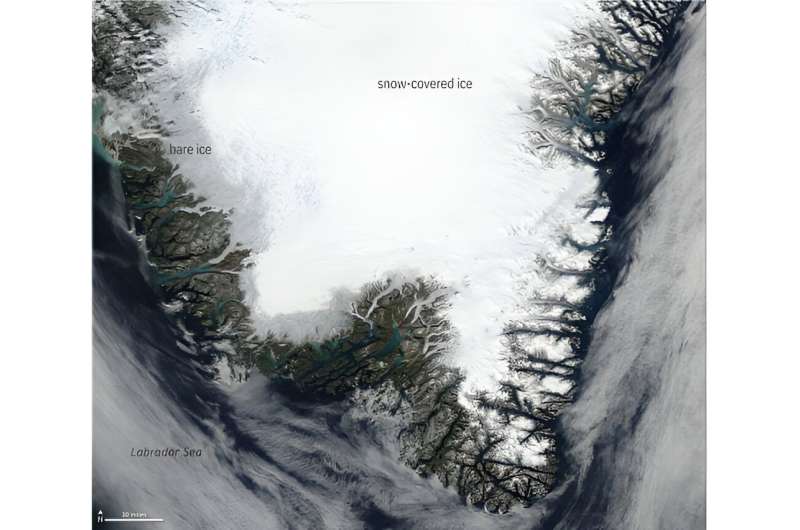
Satellite image similar to the photograph of southern Greenland on the afternoon of September 4, 2022. The bare and dirty ice at the edge of the ice sheet appears gray. Snow-covered ice is bright white. Pale blue bands and circles are lakes, rivers and meltwater ponds. Credit: NASA image, Worldview
As the planet continues to warm due to human-driven climate change, accurate computer climate models will be essential to help illuminate precisely how the climate will continue to change in the years ahead.
In a study published in Journal of Geophysical Research: Atmospheresa team led by researchers from UC Irvine’s Department of Earth System Science and the University of Michigan’s Department of Climate and Space Science and Engineering reveals how a climate model commonly used by geoscientists currently overestimates a key physical property of the system climate of the Earth called albedo. which is the degree to which the ice reflects the sunlight that warms the planet into space.
“We found that with the older model versions, the ice is highly reflective by about 5%,” said Chloe Clarke, a project scientist in UC Irvine professor Charlie Zender’s group. “The reflectivity of the ice was very high.”
The amount of sunlight the planet receives and reflects is important in estimating how much the planet will warm in the coming years. Previous versions of the model, called the Exact Energy Earth System Model (E3SM), overestimated albedo because they did not take into account what Clarke described as the microphysical properties of ice in a warming world.
These properties include the effects that things like algae and dust have on albedo. Algae and dark-colored dust can make snow and ice less reflective and less able to reflect sunlight.
To do the analysis, Clarke and her team studied satellite data to track the albedo of the Greenland ice sheet. They found that the E3SM reflectance overestimates the reflectivity of the ice sheet, “meaning that the model estimates less melting than what would be expected from the microphysical properties of the ice,” Clarke said.
But with the new ice reflection incorporated into the model, the Greenland ice sheet is melting at a rate of about six gigatons faster than in older model versions. This is based on albedo measurements that are more consistent with satellite observations.
Clarke hopes her team’s study highlights the importance of seemingly small properties that can have far-reaching consequences for the overall climate. “I think our work will help the models do a much better job of helping us capture the climate feedbacks associated with snow and ice,” she said.
Next, Clarke wants to study different icy parts of the planet to assess how widespread the albedo discrepancy is in E3SM.
“Our next steps are to get it to work globally and not just valid over Greenland,” said Clarke, who also aims to compare the melting rates of Greenland’s ice with observations to measure how much more correct is the new ice albedo. “It would be useful to apply it to glaciers in places like the Andes and Alaska.”
Other authors include Raf Antwerpen (Lamont-Doherty Earth Observatory), Mark G. Flanner (University of Michigan), Adam Schneider (National Oceanic and Atmospheric Administration), Marco Tedesco (Lamont-Doherty Earth Observatory), and Charlie S. Zender (UC Irvine). ).
More information:
CA Whicker‐Clarke et al, The Effect of Physically Based Ice Radiative Processes on Greenland Ice Sheet Albedo and Surface Mass Balance in E3SM, Journal of Geophysical Research: Atmospheres (2024). DOI: 10.1029/2023JD040241
Provided by University of California, Irvine
citation: Earth system scientists discover missing piece in climate models (2024, July 15) retrieved July 16, 2024 from https://phys.org/news/2024-07-earth-scientists-piece-climate.html
This document is subject to copyright. Except for any fair agreement for study or private research purposes, no part may be reproduced without written permission. The content is provided for informational purposes only.